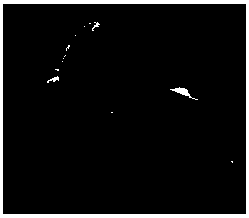Preparation method of low-sunlight amorphous silicon thin-film solar cell window layer
A technology of amorphous silicon thin film and solar cell, applied in the field of solar photovoltaic utilization, can solve the problem of low power generation efficiency in low-sunshine areas
- Summary
- Abstract
- Description
- Claims
- Application Information
AI Technical Summary
Problems solved by technology
Method used
Image
Examples
Embodiment 1
[0017] Example 1. A method for preparing a window layer of a low-insolation amorphous silicon thin-film solar cell is carried out according to the following steps:
[0018] a. Clean the surface of the conductive glass substrate and dry it;
[0019] b. Using silane, hydrogen, methane / ethane, and borane as raw material gases, deposit a P-type amorphous silicon film layer containing carbon and hydrogen on the surface of a conductive glass substrate to obtain B-containing P-type SiCx:Hy amorphous silicon The thin film battery window layer, wherein, x=1, y=1 or 2 or 3.
[0020] Specifically, in the aforementioned step b, during deposition, a B-doped SiCx:Hy amorphous silicon thin film is deposited on the surface of the conductive glass substrate by using a plasma enhanced chemical vapor deposition method.
[0021] Specifically, in the aforementioned step b, during deposition, the temperature of the conductive glass substrate is 250°C.
[0022] Specifically, in the aforementioned...
Embodiment 2
[0026] Example 2. A method for preparing a window layer of a low-insolation amorphous silicon thin-film solar cell is carried out according to the following steps:
[0027] a. Clean the surface of the conductive glass substrate and dry it;
[0028] b. Using silane, hydrogen, methane / ethane, and borane as raw material gases, deposit a P-type amorphous silicon film layer containing carbon and hydrogen on the surface of a conductive glass substrate to obtain B-containing P-type SiCx:Hy amorphous silicon The thin film battery window layer, wherein, x=1, y=1 or 2 or 3.
[0029] Specifically, in the aforementioned step b, during deposition, a B-doped SiCx:Hy amorphous silicon thin film is deposited on the surface of the conductive glass substrate by using a plasma enhanced chemical vapor deposition method.
[0030] Specifically, in the aforementioned step b, during deposition, the temperature of the conductive glass substrate is 150°C.
[0031] Specifically, in the aforementioned...
Embodiment 3
[0035] Example 3. A method for preparing a window layer of a low-insolation amorphous silicon thin-film solar cell is carried out according to the following steps:
[0036] a. Clean the surface of the conductive glass substrate and dry it;
[0037] b. Using silane, hydrogen, methane / ethane, and borane as raw material gases, deposit a P-type amorphous silicon film layer containing carbon and hydrogen on the surface of a conductive glass substrate to obtain B-containing P-type SiCx:Hy amorphous silicon The thin film battery window layer, wherein, x=1, y=1 or 2 or 3.
[0038] Specifically, in the aforementioned step b, during deposition, a B-doped SiCx:Hy amorphous silicon thin film is deposited on the surface of the conductive glass substrate by using a plasma enhanced chemical vapor deposition method.
[0039] Specifically, in the aforementioned step b, during deposition, the temperature of the conductive glass substrate is 150-350°C.
[0040] Specifically, in the aforementi...
PUM
| Property | Measurement | Unit |
|---|---|---|
| Thickness | aaaaa | aaaaa |
Abstract
Description
Claims
Application Information
 Login to View More
Login to View More - Generate Ideas
- Intellectual Property
- Life Sciences
- Materials
- Tech Scout
- Unparalleled Data Quality
- Higher Quality Content
- 60% Fewer Hallucinations
Browse by: Latest US Patents, China's latest patents, Technical Efficacy Thesaurus, Application Domain, Technology Topic, Popular Technical Reports.
© 2025 PatSnap. All rights reserved.Legal|Privacy policy|Modern Slavery Act Transparency Statement|Sitemap|About US| Contact US: help@patsnap.com

